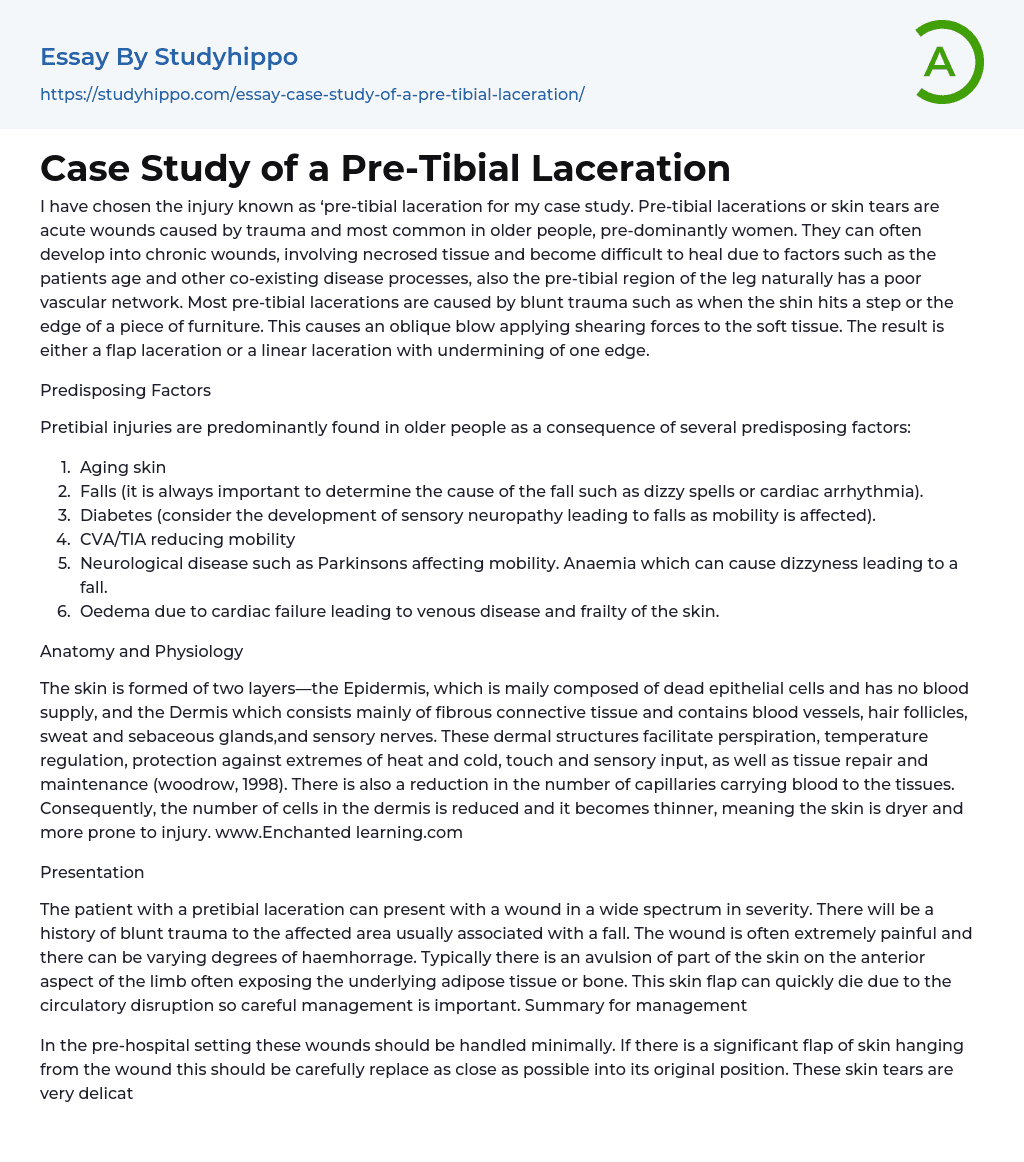In the ongoing case study I am working on, my attention is primarily geared towards a medical condition termed 'pre-tibial laceration'. This phrase refers to skin traumas or acute injuries that often occur from severe incidents. These types of wounds are typically found in elderly individuals, particularly female ones. It's fairly common for these damages to progress into chronic injuries marked by dead cells and they present significant challenges to treat due to various factors such as the ageing process of the patient, existing health complications, and the naturally inadequate blood vessel supply in the pre-tibial region of their leg. In many instances, blunt objects like collision with a staircase or furniture can lead to these lacerations creating an angular impact that exerts shearing forces onto delicate body tissues. Hence, this might result in either a flap-type wound or a linear-type wound with undermining at one side.
Predis
...
posing Factors
Primarily, pretibial injuries are discovered in aged individuals due to the presence of multiple precipitating influences:
-
Aging skin
-
Falls (it is always important to determine the cause of the fall such as dizzy spells or cardiac arrhythmia).
-
Diabetes (consider the development of sensory neuropathy leading to falls as mobility is affected).
-
CVA/TIA reducing mobility
-
Neurological disease such as Parkinsons affecting mobility. Anaemia which can cause dizzyness leading to a fall.
-
Oedema due to cardiac failure leading to venous disease and frailty of the skin.
Anatomy and Physiology
Our
View entire sample
Join StudyHippo to see entire essay
posing Factors
Primarily, pretibial injuries are discovered in aged individuals due to the presence of multiple precipitating influences:
- Aging skin
- Falls (it is always important to determine the cause of the fall such as dizzy spells or cardiac arrhythmia).
- Diabetes (consider the development of sensory neuropathy leading to falls as mobility is affected).
- CVA/TIA reducing mobility
- Neurological disease such as Parkinsons affecting mobility. Anaemia which can cause dizzyness leading to a fall.
- Oedema due to cardiac failure leading to venous disease and frailty of the skin.
Anatomy and Physiology
Our
skin comprises two distinct layers, the Epidermis and the Dermis. The former primarily consists of dead epithelial cells and lacks a blood supply, while the latter is essentially made up of fibrous connective tissue. The Dermis houses various elements such as blood vessels, hair follicles, sweat glands, sebaceous glands and sensory nerves that aid in several functions like perspiration, regulation of body heat against temperature changes, processing touch sensation along with other sensory signals and healing damaged tissues (Woodrow 1998). Furthermore, it's observed that there's a reduction in capillaries supplying blood to tissues which leads to fewer cells in the Dermis resulting in an overall thinner layer; this renders the skin drier and more prone to damage. www.EnchantedLearning.com
Presentation
A patient exhibiting a pretibial laceration can have a range of injury severity. There is typically a history of blunt trauma to the impacted area, often due to a fall. The wound commonly causes extreme pain and can exhibit various levels of bleeding. It is common for there to be an avulsion, or removal, of some skin on the front side of the limb, frequently revealing the underlying fat tissue or bone. The potential for rapid skin flap death due to circulatory disruption necessitates careful handling. This calls for efficient and effective management.
In a pre-hospital environment, it is essential to minimally manage these injuries. If there's a significant skin flap separating from the wound, gently repositioning it back to its original location is crucial. Avoid applying adhesive tapes or dressings to such susceptible skin lacerations. Instead, using non-adhesive dressings moistened with sterile saline solution would be optimal for preventing skin dryness.
The administration of pain relief should not be overlooked and must be implemented as swiftly as possible.
- Cloning essays
- Medical Ethics essays
- Patient essays
- Therapy essays
- drugs essays
- Cannabis essays
- Aspirin essays
- Cardiology essays
- Hemoglobin essays
- Pharmacology essays
- Surgery essays
- alternative medicine essays
- Plastic Surgery essays
- Organ Donation essays
- Vaccines essays
- Medical essays
- Dentist essays
- Psychological Trauma essays
- Physical therapy essays
- Cold essays
- Cocaine essays
- Why Marijuana Should Be Legalized essays
- Drug Abuse essays
- Teenage Drug Abuse essays
- Heart Disease essays
- Artery essays
- Addiction essays
- Anatomy and Physiology essays
- Biodegradation essays
- Cancer essays
- Dental Care essays
- Disability essays
- Disease essays
- Disorders essays
- Health Care essays
- Infectious Disease essays
- Inquiry essays
- Intelligence Quotient essays
- Lung Cancer essays
- Medicine essays
- Neurology essays
- Nutrition essays
- Olfaction essays
- Physical Exercise essays
- Public Health essays
- Sex essays
- Women's Health essays
- World health organization essays
- Atom essays
- Big Bang Theory essays




